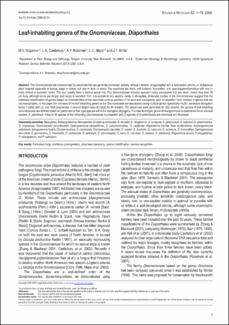| dc.creator | Sogonov, M.V. | |
| dc.creator | Castlebury, L.A. | |
| dc.creator | Rossman, A.Y. | |
| dc.creator | Mejía, Luis Carlos | |
| dc.creator | White, J.F. | |
| dc.date.accessioned | 2020-02-10T14:36:53Z | |
| dc.date.available | 2020-02-10T14:36:53Z | |
| dc.date.issued | 2008-01-01 | |
| dc.identifier.uri | http://repositorio-indicasat.org.pa/handle/123456789/13 | |
| dc.description | The Gnomoniaceae are characterised by ascomata that are generally immersed, solitary, without a stroma, or aggregated with a rudimentary stroma, in herbaceous plant material especially in leaves, twigs or stems, but also in bark or wood. The ascomata are black, soft-textured, thin-walled, and pseudoparenchymatous with one or more central or eccentric necks. The asci usually have a distinct apical ring. The Gnomoniaceae includes species having ascospores that are small, mostly less than 25 μm long, although some are longer, and range in septation from non-septate to one-septate, rarely multi-septate. Molecular studies of the Gnomoniaceae suggest that the traditional classification of genera based on characteristics of the ascomata such as position of the neck and ascospores such as septation have resulted in genera that are not monophyletic. In this paper the concepts of the leaf-inhabiting genera in the Gnomoniaceae are reevaluated using multiple genes, specifically nrLSU, translation elongation factor 1-alpha (tef1-α), and RNA polymerase II second largest subunit (rpb2) for 64 isolates. ITS sequences were generated for 322 isolates. Six genera of leaf-inhabiting Gnomoniaceae are defined based on placement of their type species within the multigene phylogeny. The new monotypic genus Ambarignomonia is established for an unusual species, A. petiolorum. A key to 59 species of leaf-inhabiting Gnomoniaceae is presented and 22 species of Gnomoniaceae are described and illustrated. | en_US |
| dc.description.abstract | The Gnomoniaceae are characterised by ascomata that are generally immersed, solitary, without a stroma, or aggregated with a rudimentary stroma, in herbaceous plant material especially in leaves, twigs or stems, but also in bark or wood. The ascomata are black, soft-textured, thin-walled, and pseudoparenchymatous with one or more central or eccentric necks. The asci usually have a distinct apical ring. The Gnomoniaceae includes species having ascospores that are small, mostly less than 25 μm long, although some are longer, and range in septation from non-septate to one-septate, rarely multi-septate. Molecular studies of the Gnomoniaceae suggest that the traditional classification of genera based on characteristics of the ascomata such as position of the neck and ascospores such as septation have resulted in genera that are not monophyletic. In this paper the concepts of the leaf-inhabiting genera in the Gnomoniaceae are reevaluated using multiple genes, specifically nrLSU, translation elongation factor 1-alpha (tef1-α), and RNA polymerase II second largest subunit (rpb2) for 64 isolates. ITS sequences were generated for 322 isolates. Six genera of leaf-inhabiting Gnomoniaceae are defined based on placement of their type species within the multigene phylogeny. The new monotypic genus Ambarignomonia is established for an unusual species, A. petiolorum. A key to 59 species of leaf-inhabiting Gnomoniaceae is presented and 22 species of Gnomoniaceae are described and illustrated. | en_US |
| dc.format | application/pdf | |
| dc.language.iso | spa | en_US |
| dc.publisher | Studies in Mycology | en_US |
| dc.rights | info:eu-repo/semantics/openAccess | |
| dc.rights | https://creativecommons.org/licenses/by-nc-nd/4.0/ | |
| dc.subject | Foliicolous fungi | en_US |
| dc.subject | Foliicolous fungi | en_US |
| dc.subject | multilocus phylogenetics | en_US |
| dc.subject | polyphasic taxonomy | en_US |
| dc.subject | species identification | en_US |
| dc.subject | species recognition | en_US |
| dc.title | Leaf-inhabiting genera of the Gnomoniaceae, Diaporthales | en_US |
| dc.type | info:eu-repo/semantics/article | |
| dc.type | info:eu-repo/semantics/publishedVersion | |

